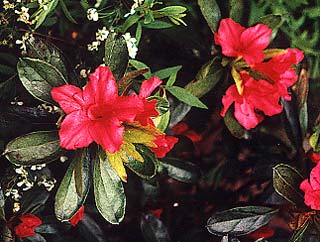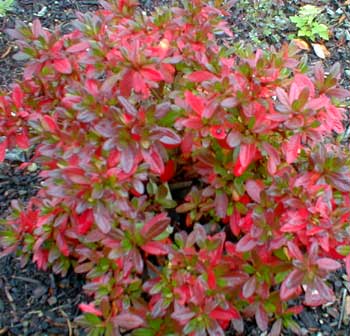 'Girard's Crimson'
'Girard's Crimson'
Evergreen Azalea
"The artist is the confidant of nature,
flowers carry on dialogues with him."
-Auguste Rodin
(1840-1917)
(1840-1917)
'Girard Crimson' Evergreen Azalea likes full sun to part sun, but will tolerate partial shade. It grows to about three feet high & four wide in ten years, has large deeply red blooms, & looks good in a group of azaleas & rhodies that likewise remain smallish in stature.
 The first close-up of the bloom was photographed mid-April (2001). Not until about May 18 did the blooms begin to get tatty, so it was in bloom a full month. The following year, after an unusually mild winter, it bloomed a week earlier & lasted only three weeks. But other springs it was only still only in full bud on May 1, as in the second photo, & flowers lasted into June.
The first close-up of the bloom was photographed mid-April (2001). Not until about May 18 did the blooms begin to get tatty, so it was in bloom a full month. The following year, after an unusually mild winter, it bloomed a week earlier & lasted only three weeks. But other springs it was only still only in full bud on May 1, as in the second photo, & flowers lasted into June.For me, the Girard Crimson was of especial interest because I'm always on the look-out for stuff I find pretty the rest of the year, when not blooming. Not only is the 'Girard Crimson' flower bright & wonderful, but additionally the deep green leaf shape stands out as being "itself" within a grouping of evergreen azaleas each with differing leaves.
After a good autumn frost the leaves take on bright red & copper hues for late Autumn & Winter. The third photo from November (2005) shows another 'Girard Crimson,' this one in fuller sun, with such bright autumn color as to practically constitute a second flowering. See the 'Girard Crmson' Page of the Rhodies & Azaleas Autumn Leaves Gallery for more leaf portraits.
'Girard Crimson' rather closely resembles 'Mother's Day' Azalea which blooms about the same time. They are matches both for leaf appearance, upright stance, & bloom color, so could be regarded as redundant in the garden. But 'Mother's Day' blossoms are semi-double & "hose-in-hose" meaning it has funnels within funnels for a frillier layered look, whereas 'Girard's Crimson' is a simple trumpet.
 Both 'Girard Crimson' & 'Mother's Day' have blooms that generally last at least a full month & both have dark evergreen leaves that turn red or copper in late autumn & for winter. For all their similarities, an important difference is that 'Mother's Day' will in the long run be the bigger shrub; 'Girard's Crimson' spreads wider without getting tall.
Both 'Girard Crimson' & 'Mother's Day' have blooms that generally last at least a full month & both have dark evergreen leaves that turn red or copper in late autumn & for winter. For all their similarities, an important difference is that 'Mother's Day' will in the long run be the bigger shrub; 'Girard's Crimson' spreads wider without getting tall.As a group, Girard hybrids are derived from Gable hybrids, so it is difficult to sort out their species affiliations after decades of blends. We have a typical Gable hybid too, our 'Purple Splendor' Azalea. Both Gables & Girards are bred for cold hardiness & showiness of bloom.
Girard hybrid azaleas are famed for their colorful flowers on compact shrubs. When at the height of bloom, flowers can completely hide the leaves, which some will regard as too gaudy, although there will be a thinner dispersal of blooms over the shrub if it is rarely pruned, being allowed to give some of its energy to putting on new leafage. The Royal Botanic Kew Gardens, & the United States National Arboretum in Washington D.C., feature them prominantly for providing extreme border highlights.
They are particularly disease resistant, & hardy to very low temperatures, because bred to thrive even in the gawdawful winter winds that come in off Lake Erie.
The triad of famous Great Lakes Evergreen Azaela hybridizers were all from northern Ohio: Peter Girard, Sr., Joseph Martin, Sr., & Anthony Shammarello, among whom the late Peter Girard, Sr., was perhaps best known. His work was carried on by his son Peter, Jr., who is more recently deceased (in 2001), & the family business is presently run by the grandsons of the nursery's founder. An American gardening dynasty actively producing colorful shrubs since 1946!